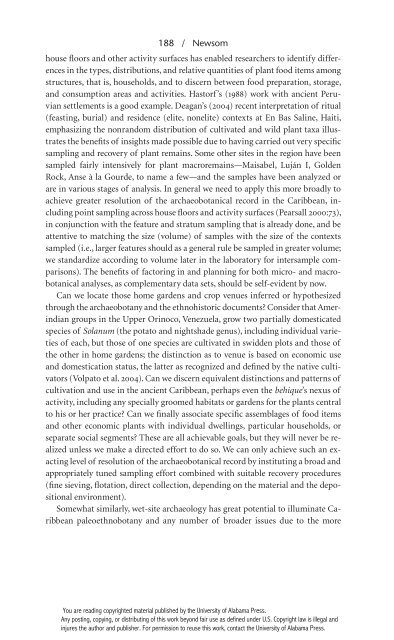Crossing the Borders: New Methods and Techniques in the Study of Archaeological Materials from the Caribbean
by Corrine L. Hoffman, et. al.
by Corrine L. Hoffman, et. al.
Create successful ePaper yourself
Turn your PDF publications into a flip-book with our unique Google optimized e-Paper software.
188 / <strong>New</strong>som<br />
house floors <strong>and</strong> o<strong>the</strong>r activity surfaces has enabled researchers to identify differences<br />
<strong>in</strong> <strong>the</strong> types, distributions, <strong>and</strong> relative quantities <strong>of</strong> plant food items among<br />
structures, that is, households, <strong>and</strong> to discern between food preparation, storage,<br />
<strong>and</strong> consumption areas <strong>and</strong> activities. Hastorf’s (1988) work with ancient Peruvian<br />
settlements is a good example. Deagan’s (2004) recent <strong>in</strong>terpretation <strong>of</strong> ritual<br />
(feast<strong>in</strong>g, burial) <strong>and</strong> residence (elite, nonelite) contexts at En Bas Sal<strong>in</strong>e, Haiti,<br />
emphasiz<strong>in</strong>g <strong>the</strong> nonr<strong>and</strong>om distribution <strong>of</strong> cultivated <strong>and</strong> wild plant taxa illustrates<br />
<strong>the</strong> benefits <strong>of</strong> <strong>in</strong>sights made possible due to hav<strong>in</strong>g carried out very specific<br />
sampl<strong>in</strong>g <strong>and</strong> recovery <strong>of</strong> plant rema<strong>in</strong>s. Some o<strong>the</strong>r sites <strong>in</strong> <strong>the</strong> region have been<br />
sampled fairly <strong>in</strong>tensively for plant macrorema<strong>in</strong>s— Maisabel, Luján I, Golden<br />
Rock, Anse à la Gourde, to name a few— <strong>and</strong> <strong>the</strong> samples have been analyzed or<br />
are <strong>in</strong> various stages <strong>of</strong> analysis. In general we need to apply this more broadly to<br />
achieve greater resolution <strong>of</strong> <strong>the</strong> archaeobotanical record <strong>in</strong> <strong>the</strong> <strong>Caribbean</strong>, <strong>in</strong>clud<strong>in</strong>g<br />
po<strong>in</strong>t sampl<strong>in</strong>g across house floors <strong>and</strong> activity surfaces (Pearsall 2000:73),<br />
<strong>in</strong> conjunction with <strong>the</strong> feature <strong>and</strong> stratum sampl<strong>in</strong>g that is already done, <strong>and</strong> be<br />
attentive to match<strong>in</strong>g <strong>the</strong> size (volume) <strong>of</strong> samples with <strong>the</strong> size <strong>of</strong> <strong>the</strong> contexts<br />
sampled (i.e., larger features should as a general rule be sampled <strong>in</strong> greater volume;<br />
we st<strong>and</strong>ardize accord<strong>in</strong>g to volume later <strong>in</strong> <strong>the</strong> laboratory for <strong>in</strong>tersample comparisons).<br />
The benefits <strong>of</strong> factor<strong>in</strong>g <strong>in</strong> <strong>and</strong> plann<strong>in</strong>g for both micro- <strong>and</strong> macrobotanical<br />
analyses, as complementary data sets, should be self- evident by now.<br />
Can we locate those home gardens <strong>and</strong> crop venues <strong>in</strong>ferred or hypo<strong>the</strong>sized<br />
through <strong>the</strong> archaeobotany <strong>and</strong> <strong>the</strong> ethnohistoric documents? Consider that Amer<strong>in</strong>dian<br />
groups <strong>in</strong> <strong>the</strong> Upper Or<strong>in</strong>oco, Venezuela, grow two partially domesticated<br />
species <strong>of</strong> Solanum (<strong>the</strong> potato <strong>and</strong> nightshade genus), <strong>in</strong>clud<strong>in</strong>g <strong>in</strong>dividual varieties<br />
<strong>of</strong> each, but those <strong>of</strong> one species are cultivated <strong>in</strong> swidden plots <strong>and</strong> those <strong>of</strong><br />
<strong>the</strong> o<strong>the</strong>r <strong>in</strong> home gardens; <strong>the</strong> dist<strong>in</strong>ction as to venue is based on economic use<br />
<strong>and</strong> domestication status, <strong>the</strong> latter as recognized <strong>and</strong> def<strong>in</strong>ed by <strong>the</strong> native cultivators<br />
(Volpato et al. 2004). Can we discern equivalent dist<strong>in</strong>ctions <strong>and</strong> patterns <strong>of</strong><br />
cultivation <strong>and</strong> use <strong>in</strong> <strong>the</strong> ancient <strong>Caribbean</strong>, perhaps even <strong>the</strong> behique’s nexus <strong>of</strong><br />
activity, <strong>in</strong>clud<strong>in</strong>g any specially groomed habitats or gardens for <strong>the</strong> plants central<br />
to his or her practice? Can we f<strong>in</strong>ally associate specific assemblages <strong>of</strong> food items<br />
<strong>and</strong> o<strong>the</strong>r economic plants with <strong>in</strong>dividual dwell<strong>in</strong>gs, particular households, or<br />
separate social segments? These are all achievable goals, but <strong>the</strong>y will never be realized<br />
unless we make a directed effort to do so. We can only achieve such an exact<strong>in</strong>g<br />
level <strong>of</strong> resolution <strong>of</strong> <strong>the</strong> archaeobotanical record by <strong>in</strong>stitut<strong>in</strong>g a broad <strong>and</strong><br />
appropriately tuned sampl<strong>in</strong>g effort comb<strong>in</strong>ed with suitable recovery procedures<br />
(f<strong>in</strong>e siev<strong>in</strong>g, flotation, direct collection, depend<strong>in</strong>g on <strong>the</strong> material <strong>and</strong> <strong>the</strong> depositional<br />
environment).<br />
Somewhat similarly, wet- site archaeology has great potential to illum<strong>in</strong>ate <strong>Caribbean</strong><br />
paleoethnobotany <strong>and</strong> any number <strong>of</strong> broader issues due to <strong>the</strong> more<br />
You are read<strong>in</strong>g copyrighted material published by <strong>the</strong> University <strong>of</strong> Alabama Press.<br />
Any post<strong>in</strong>g, copy<strong>in</strong>g, or distribut<strong>in</strong>g <strong>of</strong> this work beyond fair use as def<strong>in</strong>ed under U.S. Copyright law is illegal <strong>and</strong><br />
<strong>in</strong>jures <strong>the</strong> author <strong>and</strong> publisher. For permission to reuse this work, contact <strong>the</strong> University <strong>of</strong> Alabama Press.


















